Violence in the Zócalo
Following the death of an American journalist, the rest of the world is taking notice of the declining situation in Oaxaca. Our writer interviews his sister Anna, who watched the peace unravel first-hand this summer.
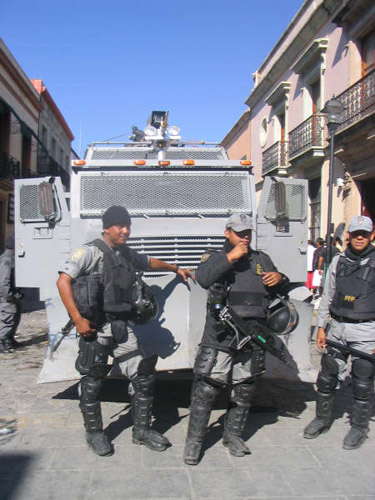
For the past five months, my sister, Anna, has been sending me emails about the state of affairs in Oaxaca, Mexico. Interning for a local NGO, she arrived in May, just as teachers and their supporters were beginning to mobilize for a mass rally that would effectively, and for an indefinite amount of time, shut down the state capital.
Over the following few weeks, it was obvious from the urgency of Anna’s messages that the situation was escalating: Demands were not being recognized, and the atmosphere in Oaxaca’s capital city, also called Oaxaca, was increasing in hostility. Then, on June 14th, governor Ulises Ruíz Ortiz dispatched riot police into the town square (zócalo) where the protestors were camped out.
At the time, mainstream media offered very little coverage of what was going on. The protestors returned, their numbers only bolstered by the government’s violent response. Despite their pacifist leanings, clashes between the protestors and the heavily armed police became commonplace, with symbolic control of the zócalo at the center of every conflict.
Only this week, with the death of American journalist Brad Will, have major news outlets begun to pay attention to the situation. Anna is now back in Canada, but still very much connected to the cause. What follows is an attempt, through my sister’s experiences in Oaxaca, to wrap my head around what seems a significant humanitarian crisis.
All photos copyright © Ana Bonilla
Pasha Malla: What brought you to Oaxaca?
Anna Malla: I had been on exchange near Mexico City for four and a half months, and decided to finish up my final undergraduate credits in Oaxaca through an internship program. I found a placement with a local NGO (whose name I will not mention for their protection) that works alongside various indigenous and marginalized communities throughout Oaxaca, supporting them in their different economic, social, and political goals through popular education.
PM: How were things—in general, the political climate, etc.—when you arrived? How did they develop while you were there?
AM: I arrived in the capital city of Oaxaca, Oaxaca de Juarez, in mid-May 2006, at which time hundreds of public school teachers were beginning to organize, mostly coming from the capital and surrounding villages. The initial issues at stake for the teachers were, on the surface, to do with specific demands aimed at improving the education system (i.e., subsidized breakfasts for students so that they would not go to class hungry, higher salaries for the teachers, control over the material taught in the classes). Even from the beginning, though, these demands symbolized a larger struggle on the behalf of largely rural and indigenous communities to establish or maintain their basic rights.
People began to come from different areas of the state to join in the strike and protest the lack of response of the current governor, Ulises Ruíz Ortiz. There was a very calm feeling in the zócalo at that time, with people camped out in their tents all over the historic center, sharing meals, songs, and conversations with those around them. Actually, around that time I casually interviewed some participants with a friend who was writing her thesis on educational reforms in Mexico, and always found the teachers and union leaders to be very open and willing to share information with us, even though we were foreigners and they could very well have felt reason to mistrust us.
The political climate changed drastically with the attempted desalojo [evacuation] on the 14th of June. Basically, state officials sent in riot police in the middle of the night to forcefully rid the zócalo of the teachers. They used tear gas, fire, reportedly batons, and even firearms to chase the protestors out of the streets. After this event, the political climate in the city was completely different. There was more of an anxious feeling all around, and walking through the zócalo, I was constantly under the impression that something was about to happen. The streets were strewn with what was left of the teachers’ and their families’ belongings, which had been burned by the police. This violent attempt on the behalf of the state to weaken the movement actually strengthened it, and brought people from different socioeconomic sectors to the side of the teachers.
The issue has since expanded, particularly following the June 14th attack by the state officials, to a demand to rid Oaxaca of Ruíz, the current governor. He and his state government are reportedly responsible for numerous political assassinations and are extremely corrupt—I spoke with several people in villages who admitted to having been paid off by the PRI [Institutional Revolutionary Party, whose 71-year run of political dominance ended in 2000 with the election of President Vicente Fox, of the National Action Party. Although no longer in control of the presidency, the PRI continues to dominate many state governments, mostly crookedly] around election time. One of the main issues being fought for by the teachers’ movement is the right to dialogue with the government about the education system and the needs of the pueblo [people]. Sometimes this means preserving indigenous culture—teachers are fighting to alter the curriculum to suit local needs (i.e., rural schools teaching crop cultivation, local indigenous traditions, etc.). There is a general lack of accountability against which the teachers and now the APPO [Popular Organization of the Oaxacan People] are fighting.
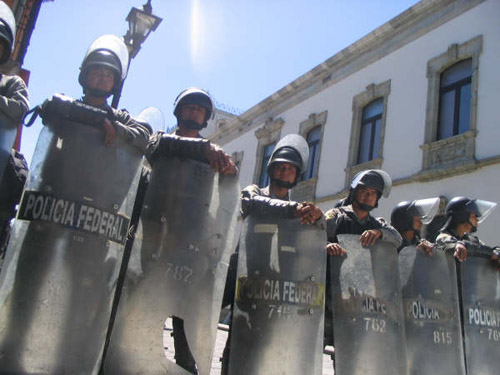
PM: Can you describe the events leading up to the teachers taking over the zócalo? What were people’s opinions in general (non-teachers or activists)?
AM: I can’t speak specifically to the events that lead up to the initial occupation of the zócalo, because I only arrived in Oaxaca a few days prior. It has been taken by the teachers and taken away and then reoccupied several times since May. I do know, however, that the strike was something that has been happening almost annually for the past several years in an attempt to get the state and/or federal governments to meet demands.
As far as people’s opinions were concerned, that is something that has definitely changed over the course of the months. At the beginning, most participants in the sit-in were teachers and their families, with some local activists joining in the struggle as well. To be honest, I think the majority of the public opinion was one of relative apathy at the beginning. People who only watch, read, and listen to the mainstream news would believe that the teachers’ sole demand was for higher salaries, and that they were just doing the same thing as the year before. But after the June 14th violent intervention by paramilitaries [private militias loyal to Ruíz and the PRI rather than the state], which was seen by most as a flagrant violation of human rights, all kinds of different people began supporting the plight of the teachers, from other service providers to members of the business community. Obviously people’s reasons for wanting to get rid of Ulises Ruíz Ortíz varied, but these all began to solidify into one, relatively unified movement.
For sure, some people just got sick of the strike, which they saw as a constant disruption to their daily lives (due to roadblocks, protests, buses not running, etc). A lot of these people stopped supporting the movement because of the perceived hassle it posed. I would say the majority who were at all interested, though, were supportive throughout the time I spent there, although I cannot speak for these past three months. I remember very clearly sitting on the plane home beside a Mexican couple who told me that the left in Mexico was losing its support because their actions were often “too radical” (i.e., creating a people’s government in Oaxaca through the APPO and stopping Ruíz from governing). Most people who supported the teachers before the June 14th event became even more vocal in their support following it.
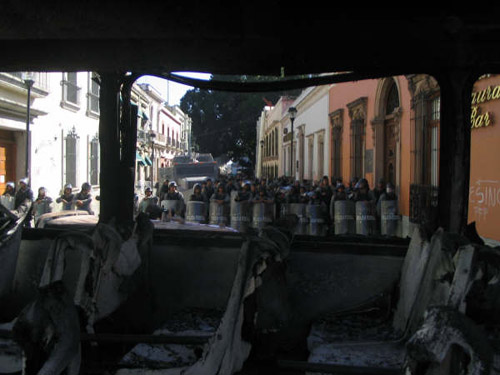
PM: What role did NGOs play in the whole business? Were there any specific events that made you either anxious to get involved or want to leave?
AM: Progressive NGOs in Oaxaca have generally been somewhere between moderately to fully in support of the teachers’ movement (vocally). They have supported it in various ways, from participating in the marches and rallies as representatives of civil society, to making meals for teachers camped out in the zócalo, to writing press releases denouncing actions taken on the part of the PRI-dominated government.
I was basically involved in the issue by virtue of my internship. The more I read, heard, learned, and witnessed, the more I believed in the necessity of this struggle and helped out in any behind-the-scenes ways possible (translations, call-outs, etc.). The only event that made me worried about my role there was the deportation of a tourist who had been working with a local NGO. Authorities in Oaxaca in particular, but also in Mexico more generally, have really clamped down on regulations around tourist visas, likely for fear of international attention to the blatant rights violations.
PM: Were there conflicting reports in the media versus what you were seeing and hearing about?
AM: Yes, definitely. Mexican mainstream media is notorious among more progressive audiences for being extremely biased towards and supportive of government action, regardless of what that may involve. They engaged in some serious covering-up tactics while I was there. Mainstream local news stations made it seem as though the officials were maintaining calm while the teachers were attempting to create a state of chaos. There was a lot of effort on the part of the people’s movement to tell the real story, in particular Radio Plantón, which was one of the main targets by the state forces when they attacked the teachers. While I was in Oaxaca, a group of women, organized by and representing various civil society groups, took over the major local television station about a month and a half into the strike, and began broadcasting a popular account of events 24 hours a day.
Even since I’ve been back in Canada I have been reading the mainstream media sources while simultaneously receiving emails and call-outs by activists and academics, and am often disgusted by the picture painted. I saw riot police chasing the teachers and their children away. I saw a helicopter flying over our houses in downtown Oaxaca and spraying teargas recklessly. I saw a man bleeding from his face that morning with friends around him healing his wound. I listened to testimonies by political prisoners. I heard about children’s and teachers’ deaths the day of the 14th of June. The mainstream media were not telling these stories.
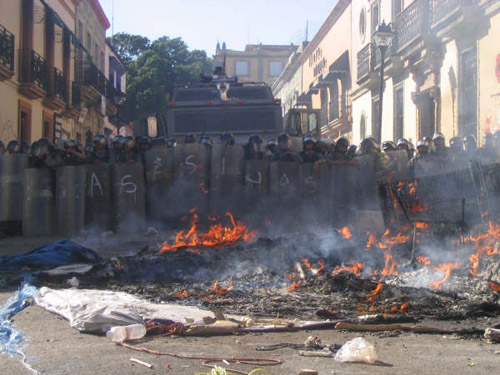
PM: What was the reaction in the rest of Mexico?
AM: That really depends on who you talk to. A large percentage of members of the upper classes in Mexico tend to look down upon “people’s” movements, while a great majority of politically active and socially aware people would at least support the aims of the movement, if not their actions. On the other hand, some of the most marginalized peoples in Mexico have trouble supporting the movement because they have paid for the schooling of their children and will not be able to afford that again, and are upset about the strike. I think the best way to answer that would be to say that most people with any kind of social conscience in Mexico support the aims of the movement but some have trouble with the ways in which those goals are being attained.
PM: What was your general experience being from Canada and knowing you were going to eventually return home? Were people skeptical of your involvement? Did you feel like your presence was actively engaged, or did you feel like more of a spectator?
AM: This is something I thought about a lot while in Mexico. I was constantly aware of my own relative privilege in that kind of a situation in the sense that I would never be directly impacted by the decisions made, and I could always go home. I did not find that anyone else was skeptical about my involvement there—and believe me, I was looking for it! I think because of my involvement with the NGO and the fact that I was not trying to make it seem as though I was out there on the front lines (because I never was and never would be) made my role there more credible, somehow. Again because of my experience with the NGO, I did feel like I was actively engaged, that I was useful in some of the processes (translations, call-outs, etc.) and only felt like a spectator at times when I chose to be in the background. Like, for instance, at the first big march after the June 14th attack, I sat behind the gathering in the park, watching 100 people turn into half a million. It made more sense for me to be a spectator at that event, and is a moment I will not soon forget.
PM: Was the atmosphere among the teachers and activists hopeful? How would you compare this protest to something similar in North America?
AM: I definitely got the sense from the beginning of my interactions with teachers and other members of civil society that they were not backing down until their demands were met, so yes, in that sense, the atmosphere was hopeful. Perhaps hopeful, but jaded from decades of struggle within a context of little to no accountability on the part of politicians, military, etc.
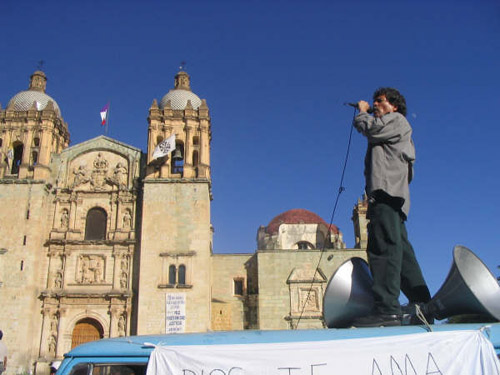
In terms of comparing this movement and these protests to something in North America: not even possible. I think it is mostly to do with the fact that there is just so much more at stake for the majority of Mexicans who are participating in this type of protest. Most people on the front lines facing riot cops in Mexico are the ones who will lose out, possibly even lose the ability to support themselves, whereas in Canada and the U.S., a huge percentage of people involved in the movements are middle-class activists. That is not a criticism, necessarily, but it is a reality that many of these American and Canadian activists can go home to their warm houses after a protest, while for the majority of Mexican activists, they are not willing to back down until their demands are met because they can’t afford to.
PM: When there were initial clashes with police and paramilitaries, was there talk of abandoning the protest? Did you witness any violence first-hand?
AM: After the June 14th attack, there was some talk about stopping the sit-in, but instead the tactics were changed—many schools ended up housing the teachers so that they would no longer be vulnerable to police attacks in the city center. Each time there has been a perceived setback, the movement has become stronger.
The violence I witnessed firsthand was later on in the morning of the 14th of June, so I missed the worst of it. But I did see riot cops chasing protestors, tear gas being sprayed all over the place, and a man bleeding from his face nearby, I’m assuming after having been hit by a police baton.
The most shocking stories I heard were during a transcription of an interview with a political prisoner who had recently been set free. His accounts of being held, threatened, and psychologically tortured (along with a few other compañeros) by police officers without warrant for his arrest were just so shocking to me.
PM: Now that the zócalo has been cleared, what do you think the protestors’ next move should or will be? Is the cause lost?
AM: I can’t really speak to what I think the protestors’ next move should or will be, but I do not believe the cause is lost. I do not see this struggle stopping until Ruíz has stepped down, justice has been served, and there is recognition of the human rights’ violations that have occurred. Who knows how long that will take or what will happen in the meantime. The recent murder of activist and journalist Bradley Will has really sent out alarm signals to people internationally, especially in the U.S., so hopefully this will be enough to get human rights organizations involved to hold state and federal authorities accountable. The struggle definitely continues.
